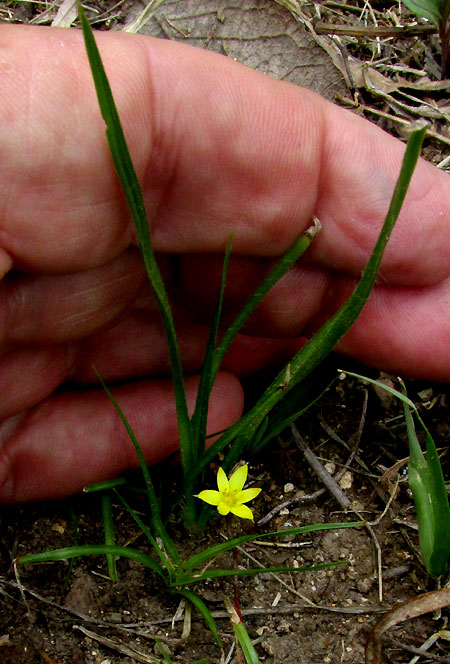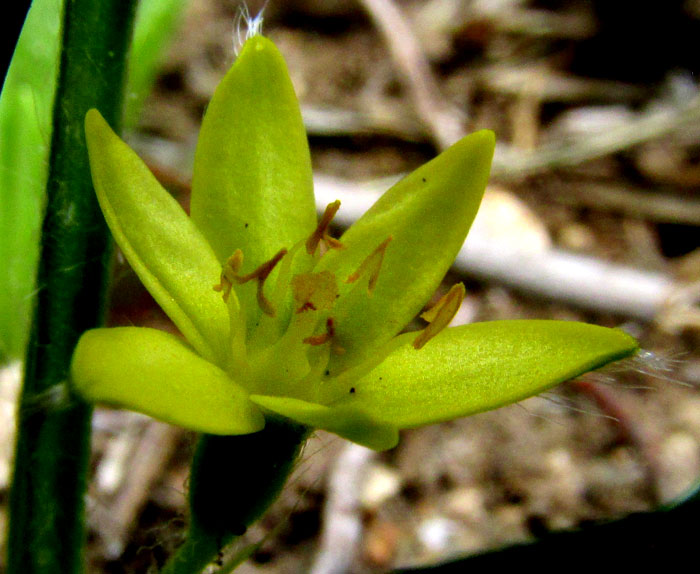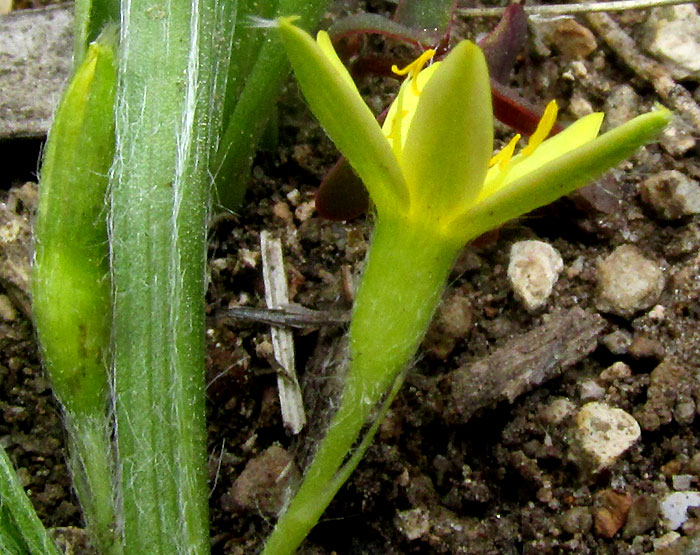Excerpts from Jim Conrad's
Naturalist Newsletter
entry from field notes dated June 28, 2022, taken in oak forest on slopes of Cerro de la Cruz, elevation ~2800m (~9200 ft), rising on the south side of the community of El Pinar, Amealco de Bonfil, Querétaro, MÉXICO, (~N20.17°, ~W100.17°)
MEXICAN YELLOW STAR-GRASS
 On the steep footpath winding through the oak woods on the north face of Cerro de la Cruz, climbing toward the towering metal sculpture of Jesus on the Cross at the very top, the little flower at the right was the only speck of bright color in an otherwise droughty-gray, brown and dusty-dark-green landscape. It and several other individuals of its kind showed a definite preference for the trail edge, not appearing elsewhere in the forest.
On the steep footpath winding through the oak woods on the north face of Cerro de la Cruz, climbing toward the towering metal sculpture of Jesus on the Cross at the very top, the little flower at the right was the only speck of bright color in an otherwise droughty-gray, brown and dusty-dark-green landscape. It and several other individuals of its kind showed a definite preference for the trail edge, not appearing elsewhere in the forest.
The plant's grasslike leaves and six yellow flower parts are typical monocot features. Most northern wildflower admirers know that such a small monocot with grasslike leaves and a little flower with six yellow divisions is a star-grass, genus Hypoxis. Star-grasses aren't grasses at all, but rather their own thing. Formerly star-grasses were considered to belong to the big Lily Family or Amaryllis Families, but nowadays most experts assign them to their own family, the Hypoxis Family, the Hypoxidaceae.
About 100 star-grass species are recognized, mostly native to southern Africa. In North America only 7 species have been documented, with about 9 or 10 in Mexico. The genus Hypoxis hasn't been well studied in our area, and the Flora of North America explains that "Relationships among the species in the flora are uncertain and will remain so until a better understanding of the primarily African H. angustifolia complex is reached." Also, the main features differentiating the species are based on the appearance of mature seeds, which we don't have, and features of the rootstock, which I'm unwilling to dig up.
However, our little path-side plant does show some important field marks:

First, there's the typical Hypoxis flower, showing six yellow tepals, the term tepal being used when there's no clear distinction between a calyx and a corolla. The six stamens bear anthers that are "sagitate," meaning that they're shaped like arrowheads, each with two basal lobes prolonged downward.

The above picture shows important features helping with figuring out the species. First, both the leaf at the picture's left and the blossom's bottom bear long, soft hairs. The tepals' undersides are greenish yellow. The flower's urn-shaped bottom part narrows to a short stem-like pedicel. At the pedicel's bottom, a short, slender, sharp-pointed, upwardly directed, leaf-like bract is attached, and then the flower stem continues on down as the peduncle. The relative lengths of these parts is distinctive. The flower's urn-shaped bottom is slightly shorter than the tepals' lengths. The pedicel is shorter than the bract, which is of similar length as the urn-shaped bottom.
These features match those of the most widely distributed and commonly occurring Mexican star-grass species, the Mexican Yellow Star-grass, HYPOXIS DECUMBENS, spottily occurring in a variety of habitats across most of Mexico and here and there in the Caribbean, south into South America as far as northern Argentina and Bolivia. With such a large distribution area and many isolated populations, local variations are bound to arise, and probably someday someone will fracture the species into many taxa.
Star-grasses arise from underground parts variously described as bulbs, rhizomes or corms. They're reportedly eaten by some people, though they're so small they must be desperation foods.
Our little Mexican Yellow Star-grass unexpectedly appears along a path, offering a little charm to a strenuous climb, but refusing to neatly fit human preconceptions about what and how she should be. I like that and have no problem with letting it go as such.